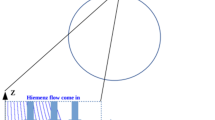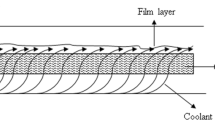Abstract
To predict the integral performance of transpiration and ablation cooling during the reentry of hypersonic vehicles, an unsteady numerical model based on the assumption of thermal equilibrium is presented. The non-thermal equilibrium model and the thermal equilibrium model are coupled by the effective thermal properties of the porous matrix and the coolant. The calculation using the thermal equilibrium model shows the influence of the variation of the effective thermal properties on the numerical results by a comparison between constant and variable thermal properties. The comparison indicates that near the melting temperature of the porous matrix, the position of the moving boundary due to ablation is sensitive to the temperature, therefore, the variation of the thermal properties are considered in this paper. The process of ablation and transpiration cooling is simulated under different numerical conditions. The simulations demonstrate that the injection rate of coolant mass flow and initial temperature of cooling are important parameters for the control of the ablation process.















Similar content being viewed by others
Abbreviations
- c :
-
Specific heat capacity [J/(kgK)]
- d p :
-
Mean diameter of pore (m)
- k :
-
Thermal conductivity [W/(mK)]
- l :
-
Initial thickness of porous plate (m)
- h s :
-
Interfacial heat transfer coefficient [W/(m2K)]
- h v :
-
Volumetric heat transfer coefficient [W/(m3K)]
- S :
-
Thickness (m)
- T :
-
Temperature (K)
- t :
-
Time (s)
- v :
-
Velocity (m/s)
- y :
-
Coordinate
- Q 0 :
-
Heat flux (W/m2)
- \(\dot{m}_{\rm c}\) :
-
Coolant mass flow rate [kg/(m2s)]
- \(\vec{V}\) :
-
Velocity vector (m/s)
- α:
-
Thermal diffusivity (m2/s)
- β:
-
Thermal polarizability
- ɛ:
-
Porosity
- ρ:
-
Density (kg/m2)
- λ:
-
Latent heat of the solid matrix (J/kg)
- 0:
-
Initial time
- c:
-
Constant/coolant
- e:
-
Effective
- m:
-
Ablation
- p:
-
Porous material
References
Agapiou JS, de Vries MF (1989) An Experimental determination of the thermal conductivity of a 304L Stainless steel powder metallurgy material. ASME J Heat Transfer 111:281–292
Alazmi B, Vafai K (2000) analysis of fluid flow and heat transfer interfacial conditions between a porous medium and a fluid layer. Int J Heat Mass Transfer 44:1735–1749
Alazmi B, Vafai K (2002) Constant wall heat flux boundary conditions in porous media under local thermal non-equilibrium conditions. Int J Heat Mass Transfer 45:3071–3087
Amiri A, Vafai K (1994) Analyses of dispersion effects and non-thermal equilibrium, non- darcian, variable porous incompressible flow through porous media. Int J Heat and Mass Transfer 37:939–954
Argento C, Bouvard D (1996) Modeling the effective thermal conductivity of random packing of spheres through densification. Int J Heat Mass Transfer 39:1343–1350
Bauer TH (1993) A general analytical approach toward the thermal conductivity of porous media. Int J Heat Mass Transfer 36:4181–4191
Choi SH, Scotti SJ, Song KD, Reis H (1997) Transpiration cooling of a scram jet engine combustion chamber. In: The 32th AIAA thermophysics conference, Atlanta, Georgia, AIAA 97–2576
Crank J (1984) Free and moving boundary problems. Clarendon Press, Oxford
Garayev KG (1999) Optimal injection of coolant into the laminar boundary layer of a compressible gas. J Appl Math Mech 65(2):253–259
Glass DE, Dilley AD (1999) Numerical analysis of convection/transpiration cooling, NASA/TM-1999–209828
Gonzo EE (2002) Estimating correlations for the effective thermal conductivity of granular materials. Chem Eng J 90:299–302
Jeng TM, Wang MP, Hwang GJ, Hung YH (2004) A new semi-empirical model for predicting heat transfer characteristics in porous channels. Exp Ther Fluid Sci 29:9–21
Jiang P, Ren ZP, Wang BX (1999) Numerical simulation of forced convection heat transfer in porous plate channels using thermal equilibrium and nonthermal equilibrium models. Numerical Heat Transfer Part A 35:99–113
Khosla PK, Rubin SG (1974) A diagonally dominant second order accurate implicit scheme. Comput Fluid 2:207–209
Krupiczka R (1967) Analysis of thermal conductivity in granular materials. Int Chem Eng 7:122–144
Kuwahara F, Shirota M, Nakayama A (2001) A numerical study of interfacial convective heat transfer coefficient in two-energy equation model for convection in porous media. Int J Heat Mass Transfer 44:1153–1159
Lee D, Vafai K (1999) Analytical characterization and conceptual assessment of solid and fluid temperature differentials in porous media. Int J Heat Mass Transfer 42:423–435
Minkowycz WJ, Haji-Sheikh A, Vafai K (1999) on departure from local thermal equilibrium in porous media due to a rapidly changing heat source: the Sparrow number. Int J Heat Mass Transfer 42:3373–3385
Mori S, Kumita M, Takahashi T, Tanimoto A, Sakakibara M (1997) Heat and mass transfer from a flat plate of finite thickness to a boundary layer flow with transpiration. Energy Convers Manage 38(10–13):1209–1218
Nield DA (2002) A note on the modeling of local thermal non-equilibrium in structured porous medium. Int J Heat Mass Transfer 45:4367–4368
Nield DA, Bejan A (1999) Convection in Porous Media, 2nd edn. Springer, Berlin Heidelberg New York, p 26
Oezisik MN (1993) Heat conduction, 2nd edn. Wiley, New York, pp 392–433
Perry RH, Chilton CH (1984) Chemical engineers’ handbook, 6th edn. McGraw-Hill, New York
Polezhaev YV, Seliverstov EM (2002) A universal model of heat transfer in systems with penetration cooling. High Temp 40:856–864
Schumann TEW (1929) Heat transfer: a liquid flowing through a porous prism. J Franklin Inst 208:405–416
Stefan J (1889) Ueber die Theorie der Eisbildung, insbesondere ueber die Eisbildung im Polarmeere, Wien. Akad Mat Nat 98(11a):965–983
Tavman IH (1996) Effective thermal conductivity of granular porous materials. Int Commun Heat Mass Transfer 23:169–176
Tien CL, Vafai K (1990) Convective and radiative heat transfer in porous media. Adv Appl Mech 27:225–281
Trevino C, Medina A (1999) Analysis of transpiration cooling of a thin porous plate in a hot laminar convective flow. Eur J Mech B Fluids 18(2):227–243
Vargaftik NB (1975) Tables of thermophysical properties of liquids and gases, 2nd edn. Hemisphere Publishing Corportion, Washington
Zhang Y, Faghri A (1999) Melting of a subcooled mixed powder bed with constant heat flux heating. Int J Heat Mass Transfer 42:775–788
Tan Z, Guo G (1994) Thermal property of engineering alloy (in Chinese). Metallurgy Publisher, Beijing
Acknowledgements
The project is supported by National Natural Science Foundation of China (No. 90305006) and Educational Administration Foundation of Anhui Province (No. 2004kj365zd). One of the authors (Jianhua Wang) is also grateful for the financial support provided by the Foundation of the Education Ministry of China for the Returned Overseas Scholars. We also thank Prof. Casey and Dr. Messner at the Institute of Thermal Fluid- Machinery and Laboratory of University Stuttgart for their helpful guidance and support. The first figure of this paper is taken from the paper of Choi et al. [7], we would like to express our appreciation to the authors.
Author information
Authors and Affiliations
Corresponding author
Rights and permissions
About this article
Cite this article
Wang, J., Han, X. Numerical investigation of transpiration and ablation cooling. Heat Mass Transfer 43, 275–284 (2007). https://doi.org/10.1007/s00231-005-0073-7
Received:
Accepted:
Published:
Issue Date:
DOI: https://doi.org/10.1007/s00231-005-0073-7




